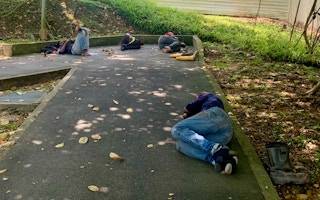Heat strain could drain Singapore’s economic output by US$1.68 billion a year by 2035, according to a new study by the Yong Loo Lin School of Medicine at the National University of Singapore (NUS).
To continue reading, subscribe to Eco‑Business.
There's something for everyone. We offer a range of subscription plans.
- Access our stories and receive our Insights Weekly newsletter with the free EB Member plan.
- Unlock unlimited access to our content and archive with EB Circle.
- Publish your content with EB Premium.
Extreme heat cost Southeast Asia’s third largest economy US$882 million in 2018, with an 11 per cent drop in average productivity observed across the city-state’s key business sectors that year. The percentage drop in productivity from heat stress will rise to 14 per cent in the next decade as Singapore warms, with the largest productivity decline expected in the country’s construction sector, the research projected.
The tropical city-state, which is located just 1 degree north of the equator, is heating at twice the global average as a result of ongoing urbanisation, deforestation, as well as background global warming, with maximum daily temperatures in Singapore projected to reach 35 to 37°C by the end of the century.
Heat stress occurs when the body cannot cool down through perspiration, causing body temperature to rise rapidly, and potentially damaging the brain and other vital organs.
The study found that on hot days of 32°C or above, the income of construction workers dropped by US$15.70 per worker due to lower levels of productivity caused by heat stress, which equates to about a quarter of the average daily salary among foreign labourers in Singapore.
NUS researchers noted that heat stress has a greater impact on cognitive function than physical performance, with impaired decision-making putting workers at risk of injury. An average of 34 migrant workers have died in work-related incidents in Singapore yearly since 2020, mainly as a result of falling from height. Two workers have died from heat stroke.
Heat stress also poses a significant risk to Singapore’s fertility rate, which has fallen from 1.8 children per couple in 1980 to less than one child per couple in 2023. The study found that heat stress also lowered sperm count and concentration among men as it affected the mobility and quality of sperm cells.
The researchers recommended men wear loose-fitting clothing and avoid warm showers and baths to counter the effects of heat on the body and overall fertility.
The research comes amid continued debate over how land-use change in Singapore affects urban heating. Singapore could lose forests that cover 10 per cent of its land area to development over the coming 10 to 15 years, which can be up to 4°C cooler than high-density urban areas.
In addition to further localised heating in urban areas, experts have noted that the loss of Singapore’s unprotected secondary forests could lead to a rise in air-conditioning costs, higher levels of air pollution, more cases of heat-related illness, and increased mortality.
The government has said that its tree-planting scheme, “One Million Trees”, an initiative to plant a million trees across Singapore by 2030, will help to mitigate the urban heat island effect.
Among the interventions recommended by NUS researchers to protect outdoor workers from dangerous levels of heat were regular rest and water breaks and the consumption of ice slurries.

















